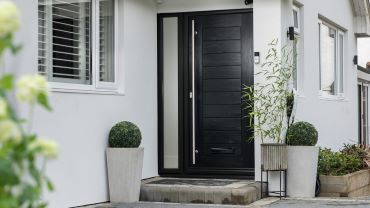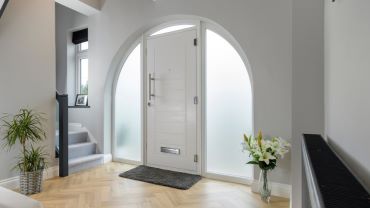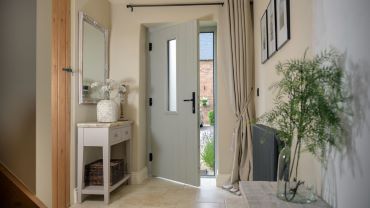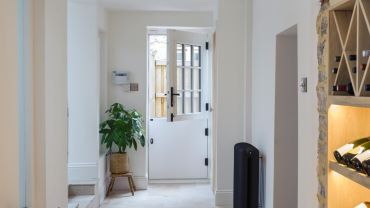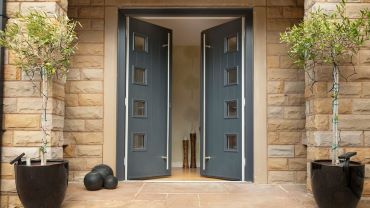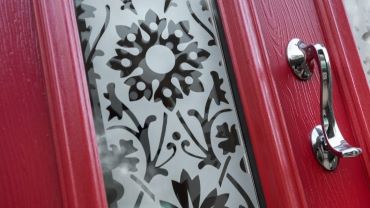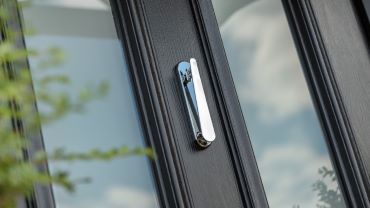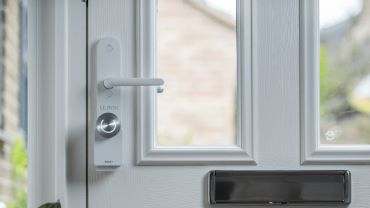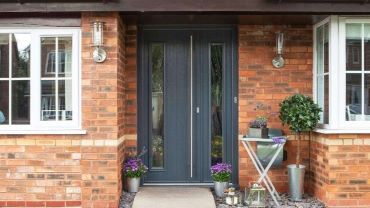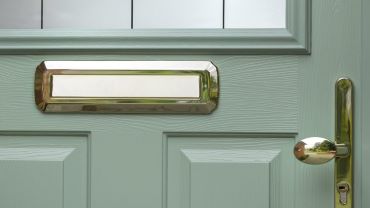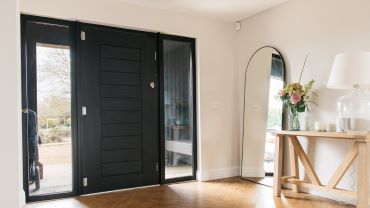Introduction
After choosing to buy a composite door, people quickly discover that selecting and spec’ing involves a whole raft of decisions, some of which are self-explanatory and some require a bit of research. But they can all have a big impact on both the price of a composite front door and its performance.
Armed with the right information, you can design a composite door that perfectly matches your priorities and ensures you’re getting everything you need, and nothing that you don’t. Because, let’s face it, the price of a composite door will be one of the defining factors in whether you choose to go down that route, or opt for something else.
How much does a
composite door cost?
Composite door costs vary enormously: they come with a huge array of options after all. From basic constructions and standard colours to one-off designs, bespoke finishes and smart tech, the price of a fully fitted composite door depends to a large degree on the details.
And while you won’t exactly need an engineering degree to understand the options, the sheer number of them can make it difficult to calculate the effect on price. All this is before you even begin to factor in the savings you could make over time on energy bills, longer-lasting hardware or lower insurance premiums.
How do composite door prices compare to other door materials?
Average cost of a composite door
The average costs of a composite front door typically range from £1,000 up to around £3,000, depending on customisation. This represents genuinely good value for money due to the durability, insulation and low maintenance.
Average cost of a uPVC door
uPVC doors are the budget-friendly option, with prices starting as low as £340. However, they lack the robustness and insulation of composite doors.
Average cost of an Aluminium door
Aluminium doors range from £1,500 up to prices in the tens of thousands for bespoke designs and functionality. They’re sleek and strong but less thermally efficient than composite options.
Average cost of a solid wood door
Solid wood doors cost anywhere from £1,000 to £4,000. While beautiful, they require more maintenance and aren’t as energy efficient as composite alternatives.
What factors impact composite door price?
Let’s have a look at the many factors that affect composite door price.
From the type of door to the materials, finishes and even locks, it’s important to weigh up your options carefully. All of these things can influence the price you pay up front and the value you get over time.
Here’s what you’ll need to consider:
Types of door
Once you’ve settled on a material for your door, the next step is to find the right type. The type of door you choose will depend on many things: the climate, the setting, age and architecture of your home, the area you live in and even the way you plan on using it. A well-chosen, high-quality modern entrance door can increase the value of your home.
In the right context, all external door types have something to offer. Whether it’s complementing period features, brightening up a gloomy hallway or just giving you the ability to hand a cup of tea into the garden without letting the dogs out, the type of door has to deliver for you.
Single doors
Single composite doors are the most straightforward option. They’re perfect for standard-sized entrances and are generally the most cost-effective choice. There’s still a lot of scope for personalisation with finishes, glazing options and hardware but their simplicity makes them a popular starting point.
Double / French doors
Double or ‘French’ doors make an impressive entry and can really complement grander façades. In terms of practicalities, they’re ideal for wider openings and spaces where light and access are priorities. However, as they’re essentially two doors, the additional manufacturing and material mean they will cost more than a single door.
Stable doors
If practicality is high on your list, a stable door could be the answer. The split-panel design means you can open the top half independently, which is a bonus for ventilation or keeping pets and children secure. If your decisions are more ‘vibes-based’, stable doors can add real character in the right setting, conjuring genuine rustic charm. The design adds to their cost but offers versatility you won’t get with other door types.
Arched doors
Arched doors are definitely a striking choice. Whether your decision to go with an arched door is driven by the unique aesthetic or by necessity (if your doorway is arched), they can require precise, bespoke manufacturing. This adds to their appeal but inevitably, to their price tag as well, which puts them more in the ‘luxury’ category. But fear not, if your doorway is arched but budget is a concern, you can opt for a rectangular composite door in an arched frame with a fanlight.
Side panels
Adding side panels can really enhance an entryway, letting in more natural light and creating a feeling of space. They’re also a simple way to fill a wide, or unusually shaped doorway. They’re available in various designs, from simple frosted glass to intricate decorative glazing patterns, but each addition increases the overall cost.
Door styles
Traditional
Traditional composite doors often feature classic panel designs, muted colours and heritage-inspired glazing. They’re ideal for period homes or creating that ‘timeless’ feel.
Traditional style composite doors balance the enduring charisma of classic design with the performance of modern engineering.
Expect to pay a little extra for authentic period details though.
Contemporary
Contemporary composite doors are the go-to for more modern styles and avant-garde architecture.
Clean lines, bold colours and minimalist hardware go well with this style.
Premium finishes or unique designs may add to the cost but are worth it if you’re looking to make a striking first impression.
Download your brochure
What door will you choose to welcome you home?
Download our brochure to see our range of door designs, colours and glazing options.
Get inspiration to create your own door and become house proud.
Door colours
OK, so you’ve chosen your door material, picked the type and selected the style of exterior door that best suits your architecture, budget and security requirements. Next: colour.
Door colour is an extension of your personal style. Bold, vibrant colours stand out and make a statement, while neutral tones create a subtler, more calming mood.
Choose a door colour that aligns with your architecture. Black composite doors are popular for traditional houses, as are other classic colours like navy or olive green. Depending on the style, modern homes often suit understatement, like anthracite, rosewood or grey composite doors, but they can also work with brighter hues like yellow and red.
Consider whether the colour blends with or stands out from the surrounding houses. The atmosphere of a neighbourhood is partly created by the palette of its houses and buildings, so think carefully about how your colour scheme fits into that.
Whether it’s brick, stone, render or paintwork, a door colour can either contrast with or complement the colours and materials of your exterior. For example, light brickwork pairs well with dark doors, while red brick may look better with pastel, neutral or white composite doors.
Door colour can affect the overall curb appeal and potential resale value of your home. If selling the house is a consideration, neutral and classic colours like black, grey or white tend to appeal to a wider audience.
UV-resistance is particularly important to prevent your door from fading over time, especially if your facade gets a lot of sunlight. Choose a low-maintenance, weather-resistant finish to reduce repair, repainting and renovation costs. For example, composite door colours will stay bright for years with minimal upkeep.
Door glazing
Composite doors with glass panels can transform your entry. It’s a nice way to add visual interest and a personal touch, and of course a simple way to illuminate your hallway.
With options including bevelled, coloured and textured glass, composite door glass designs can create unique effects. The prism formed by bevelled glass casts rainbow reflections, and coloured panes throw subtle hues across walls and floors. If you’re feeling creative, you could even incorporate this into your interior design scheme.
A glazed panel can add a sense of security. With a frosted or obscured finish allowing natural light through, while providing a high level of obscurity. Laminated or toughened safety glass can also add protection against break-ins and accidental damage. Laminated glass meets the criteria for the police preferred specification ‘Secure by Design’. This means that it’s as secure as a solid door. Some insurers recognise homes that incorporate Secured by Design certified products, which can lead to lower premiums with certain providers.
So, a glazed composite door can add personality to the exterior as well as the interior, and modern security standards mean you don’t have to compromise on aesthetics or safety.
Security
Door security is just as important as style, if not more so. Your front door security is especially important, as almost two thirds of UK burglaries happen via the front. Material and construction are two of the most significant aspects of door security. Wood, aluminium, uPVC and composite door security varies, so each one should be examined to understand which best suits your needs.
Composite doors are generally more secure than other domestic entrance doors. Solid timber core composite doors contain layers of wood, reinforced plastic, toughened glass and fiberglass. This gives them a highly durable structure. As a result, composite doors are robust and extremely reliable.
If they are thick and well-maintained, traditional solid hardwood doors can be very strong, providing good resistance against forced entry. Weather damage can cause them to swell, shrink or crack. This reduces their structural integrity and makes them easier to force or kick in, compared to aluminium or composite doors.
Due to their metal construction, aluminium doors can be highly resistant to forced entry. However, if they’re not properly installed or maintained, and are paired with a weak frame or lock, their security can be compromised.
uPVC doors are affordable and low-maintenance, and many come with multi-point locking systems. Better quality uPVC doors also come with reinforced metal frames. However, they are often less structurally sound than wood, aluminium or composite doors. They can also become brittle over time, which makes them susceptible to cracking or breaking under pressure.
Always make sure locks, hinges and glazed panels are tested and certified under standards such as BSI Kitemark or Secure by Design, which signify high resistance to burglary techniques.
Traditional handles
When considering security options for an exterior entrance door, traditional locks can be a reliable and cost-effective solution. There are ways to enhance a traditional lock for better front door security. For example a deadbolt can add an extra layer of security, without adding drastically to the cost.
Multi-point locks
Although traditional locks are generally a solid option, they can be vulnerable to lock picking and physical attacks. This is where multi-point locking can have significant advantages. The multiple locking points along the frame make them far harder to force and the extra complexity of their internal mechanisms makes them harder to pick. On top of this, most modern multi-point locks come with additional features, such as ‘double sacrificial snap protection’, which prevents anyone from snapping the lock, a common technique in break-ins.
Smart locks
Smart locks combine smart technology with convenience and peace of mind. They work remotely, can be opened hands free with keyless technology and can even be set to lock automatically when you leave the house.
The best door locks are now compatible with smart door locking, so you don’t have to sacrifice security in favour of convenience.
Thermal efficiency
Solid timber core
If insulation and durability are priorities, a solid timber core is the premium option. They tend to cost more up front but they certainly pay off in reduced energy bills over time.
GRP
Glass Reinforced Plastic (GRP) doors consist of two outer skins binded to a frame filled with insulating foam. They work by trapping heat and keeping cold air out. They offer excellent thermal performance, they’re lighter than timber-core doors and often more affordable, which makes them a great choice for energy efficiency on a budget.
Visualise your new door
Now you’ve considered every option, you will have a pretty good idea of your perfect door. The next step is to view all your chosen features in one place.
It’s one thing to imagine them separately, but until you’ve seen them all together and in context, you can’t be totally sure you’ve got the entrance you’ve been dreaming of.
This is where visualiser tools and style inspiration can really help.
Of course, to make sure you get exactly what you need, there’s no substitute for experience. We always recommend finding a showroom, seeing and feeling the products and speaking to an expert before you commit and make your order.
Find, inspire, build
Find a local showroom
If you prefer to see a design or style in situ, why not find a local showroom?
Speak to a local expert who can guide you in all the choices available. From glazing, to styles, right through to the finer points of handles, locks and letterplates.
Create a design that is unique to your and your home.
Be inspired
With so many options it’s also good to refine your ideas by checking out some style inspiration.
Viewing a few inspiring homes to see the décor, colour schemes and styles that work in combination can be a very helpful exercise.
You should explore a few different settings for the door you’re thinking of, to make sure it will work for you.
Design your door
A good door designer tool will let you design a complete exterior door, applying everything from the material, type and style, to the colour, accessories and surroundings.
Generally, they will be intuitive and easy to use, meaning you can experiment easily with a few different variations. A really good door designer will then allow you to request a quote for your specific setup.
Brochure Download
What door will you choose to welcome you home?
Download our brochure to see our range of door designs, colours and glazing options. Get inspiration to create your own door and become house-proud.
Find your nearest approved Solidor installer.
Enter your postcode to find your nearest Solidor approved composite door installer.
